Spring的Bean生命周期,11 张高清流程图及代码,深度解析
Posted Java编程精选
tags:
篇首语:本文由小常识网(cha138.com)小编为大家整理,主要介绍了Spring的Bean生命周期,11 张高清流程图及代码,深度解析相关的知识,希望对你有一定的参考价值。
链接:
一、获取Bean
第一阶段获取Bean
AbstractBeanFactory
类的
doGetBean
方法,这里可以配合前面的 getBean方法分析文章进行阅读。
主要流程就是
2、从缓存中获取单例Bean,有则进一步判断这个Bean是不是在创建中,如果是的就等待创建完毕,否则直接返回这个Bean对象
3、如果不存在单例Bean缓存,则先进行循环依赖的解析
4、解析完毕之后先获取父类BeanFactory,获取到了则调用父类的getBean方法,不存在则先合并然后创建Bean
二、创建Bean
2.1 创建Bean之前
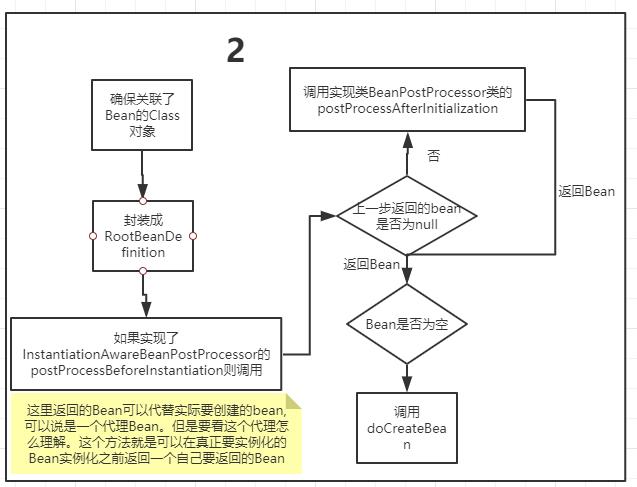
在真正创建Bean之前逻辑
AbstractAutowireCapableBeanFactory
类的
createBean
方法中。
RootBeanDefinition
对象中的Class对象并确保已经关联了要创建的Bean的Class 。
2、这里会检查3个条件
beforeInstantiationResolved
字段是否为true,默认是false。
(2)Bean是原生的Bean
(3)Bean的
hasInstantiationAwareBeanPostProcessors
属性为true,这个属性在Spring准备刷新容器钱转杯BeanPostProcessors的时候会设置,如果当前Bean实现了
InstantiationAwareBeanPostProcessor
则这个就会是true。
InstantiationAwareBeanPostProcessor
接口的
postProcessBeforeInstantiation
方法,然后获取返回的Bean,如果返回的Bean不是null还会调用实现的
BeanPostProcessor
接口的
postProcessAfterInitialization
方法,这里用代码说明
protectedObject resolveBeforeInstantiation(String beanName, RootBeanDefinition mbd) {
Object bean = null;
//条件1
if(!Boolean.FALSE.equals(mbd.beforeInstantiationResolved)) {
//条件2跟条件3
if(!mbd.isSynthetic() && hasInstantiationAwareBeanPostProcessors()) {
Class<?> targetType = determineTargetType(beanName, mbd);
if(targetType != null) {
//调用实现的postProcessBeforeInstantiation方法
bean = applyBeanPostProcessorsBeforeInstantiation(targetType, beanName);
if(bean != null) {
//调用实现的postProcessAfterInitialization方法
bean = applyBeanPostProcessorsAfterInitialization(bean, beanName);
}
}
}
//不满足2或者3的时候就会设置为false
mbd.beforeInstantiationResolved = (bean != null);
}
return bean;
}
BeanPostProcessors
的实现方法。
然后继续执行后面的
doCreateBean
方法。
2.1 真正的创建Bean,doCreateBean
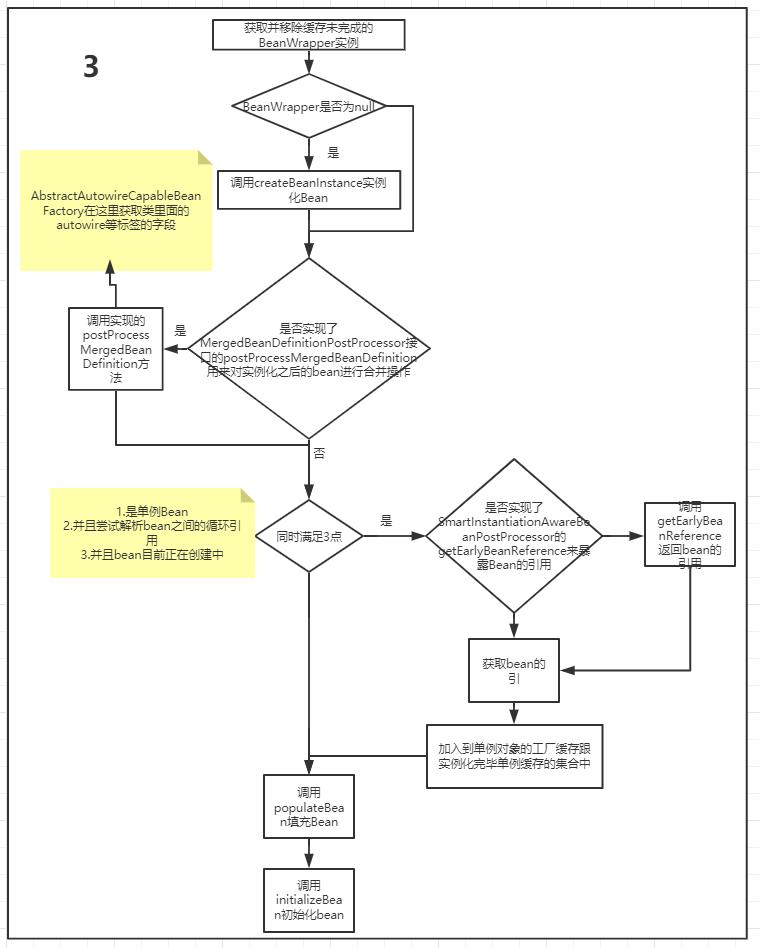
doCreateBean方法逻辑
AbstractAutowireCapableBeanFactory
方法中。
流程是
instanceWrapper
变量是不是null,这里一般是null,除非当前正在创建的Bean在
factoryBeanInstanceCache
中存在这个是保存还没创建完成的FactoryBean的集合。
2、调用createBeanInstance方法实例化Bean,这个方法在后面会讲解
3、如果当前
RootBeanDefinition
对象还没有调用过实现了的
MergedBeanDefinitionPostProcessor
接口的方法,则会进行调用 。
4、 当满足以下三点
(1)是单例Bean
(2)尝试解析bean之间的循环引用
(3)bean目前正在创建中
则会进一步检查是否实现了
SmartInstantiationAwareBeanPostProcessor
接口如果实现了则调用是实现的
getEarlyBeanReference
方法5、 调用
populateBean
方法进行属性填充,这里后面会讲解6、 调用
initializeBean
方法对Bean进行初始化,这里后面会讲解
2.1.1 实例化Bean,createBeanInstance
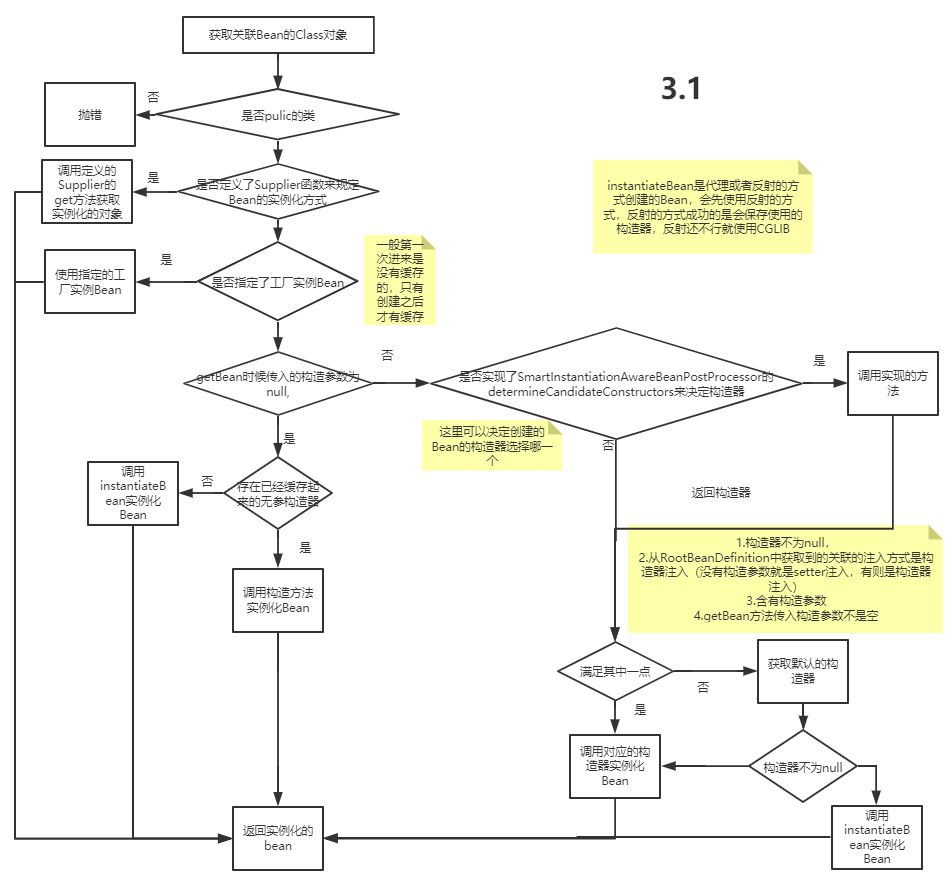
实例化Bean
protectedBeanWrapper createBeanInstance(String beanName, RootBeanDefinition mbd, @NullableObject[] args) {
//步骤1
Class<?> beanClass = resolveBeanClass(mbd, beanName);
if(beanClass != null&& !Modifier.isPublic(beanClass.getModifiers()) && !mbd.isNonPublicAccessAllowed()) {
thrownewBeanCreationException(mbd.getResourceDescription(), beanName,
"Bean class isn't public, and non-public access not allowed: "+ beanClass.getName());
}
//步骤2
Supplier<?> instanceSupplier = mbd.getInstanceSupplier();
if(instanceSupplier != null) {
return obtainFromSupplier(instanceSupplier, beanName);
}
//步骤3
if(mbd.getFactoryMethodName() != null) {
return instantiateUsingFactoryMethod(beanName, mbd, args);
}
boolean resolved = false;
boolean autowireNecessary = false;
if(args == null) {
synchronized(mbd.constructorArgumentLock) {
if(mbd.resolvedConstructorOrFactoryMethod != null) {
resolved = true;
autowireNecessary = mbd.constructorArgumentsResolved;
}
}
}
//步骤4.1
if(resolved) {
if(autowireNecessary) {
return autowireConstructor(beanName, mbd, null, null);
}
else{
return instantiateBean(beanName, mbd);
}
}
//步骤4.2
Constructor<?>[] ctors = determineConstructorsFromBeanPostProcessors(beanClass, beanName);
if(ctors != null|| mbd.getResolvedAutowireMode() == AUTOWIRE_CONSTRUCTOR ||
mbd.hasConstructorArgumentValues() || !ObjectUtils.isEmpty(args)) {
return autowireConstructor(beanName, mbd, ctors, args);
}
//步骤5
ctors = mbd.getPreferredConstructors();
if(ctors != null) {
return autowireConstructor(beanName, mbd, ctors, null);
}
return instantiateBean(beanName, mbd);
}
2、如果用户定义了Bean实例化的函数,则调用并返回
3、如果当前Bean实现了
FactoryBean
接口则调用对应的
FactoryBean
接口的
getObject
方法
4、根据getBean时候是否传入构造参数进行处理
4.1 如果没有传入构造参数,则检查是否存在已经缓存的无参构造器,有则使用构造器直接创建,没有就会调用
instantiateBean
方法先获取实例化的策略默认是
CglibSubclassingInstantiationStrategy
,然后实例化Bean。
最后返回
4.2 如果传入了构造参数,则会先检查是否实现了
SmartInstantiationAwareBeanPostProcessor
接口,如果实现了会调用
determineCandidateConstructors
获取返回的候选构造器。
4.3 检查4个条件是否满足一个
(1)构造器不为null,
(2)从RootBeanDefinition中获取到的关联的注入方式是构造器注入(没有构造参数就是setter注入,有则是构造器注入)
(3)含有构造参数
(4)getBean方法传入构造参数不是空
2.1.2 填充Bean,populateBean

填充Bean
protectedvoid populateBean(String beanName, RootBeanDefinition mbd, @NullableBeanWrapper bw) {
if(bw == null) {
if(mbd.hasPropertyValues()) {
thrownewBeanCreationException(
mbd.getResourceDescription(), beanName, "Cannot apply property values to null instance");
}
else{
// Skip property population phase for null instance.
return;
}
}
boolean continueWithPropertyPopulation = true;
//步骤1
if(!mbd.isSynthetic() && hasInstantiationAwareBeanPostProcessors()) {
for(BeanPostProcessor bp : getBeanPostProcessors()) {
if(bp instanceofInstantiationAwareBeanPostProcessor) {
InstantiationAwareBeanPostProcessor ibp = (InstantiationAwareBeanPostProcessor) bp;
if(!ibp.postProcessAfterInstantiation(bw.getWrappedInstance(), beanName)) {
continueWithPropertyPopulation = false;
break;
}
}
}
}
if(!continueWithPropertyPopulation) {
return;
}
//步骤2--------------------
PropertyValues pvs = (mbd.hasPropertyValues() ? mbd.getPropertyValues() : null);
int resolvedAutowireMode = mbd.getResolvedAutowireMode();
if(resolvedAutowireMode == AUTOWIRE_BY_NAME || resolvedAutowireMode == AUTOWIRE_BY_TYPE) {
MutablePropertyValues newPvs = newMutablePropertyValues(pvs);
// Add property values based on autowire by name if applicable.
if(resolvedAutowireMode == AUTOWIRE_BY_NAME) {
autowireByName(beanName, mbd, bw, newPvs);
}
// Add property values based on autowire by type if applicable.
if(resolvedAutowireMode == AUTOWIRE_BY_TYPE) {
autowireByType(beanName, mbd, bw, newPvs);
}
pvs = newPvs;
}
boolean hasInstAwareBpps = hasInstantiationAwareBeanPostProcessors();
boolean needsDepCheck = (mbd.getDependencyCheck() != AbstractBeanDefinition.DEPENDENCY_CHECK_NONE);
PropertyDescriptor[] filteredPds = null;
//步骤3
if(hasInstAwareBpps) {
if(pvs == null) {
pvs = mbd.getPropertyValues();
}
for(BeanPostProcessor bp : getBeanPostProcessors()) {
if(bp instanceofInstantiationAwareBeanPostProcessor) {
InstantiationAwareBeanPostProcessor ibp = (InstantiationAwareBeanPostProcessor) bp;
PropertyValues pvsToUse = ibp.postProcessProperties(pvs, bw.getWrappedInstance(), beanName);
if(pvsToUse == null) {
if(filteredPds == null) {
filteredPds = filterPropertyDescriptorsForDependencyCheck(bw, mbd.allowCaching);
}
pvsToUse = ibp.postProcessPropertyValues(pvs, filteredPds, bw.getWrappedInstance(), beanName);
if(pvsToUse == null) {
return;
}
}
pvs = pvsToUse;
}
}
}
if(needsDepCheck) {
if(filteredPds == null) {
filteredPds = filterPropertyDescriptorsForDependencyCheck(bw, mbd.allowCaching);
}
checkDependencies(beanName, mbd, filteredPds, pvs);
}
//步骤4
if(pvs != null) {
applyPropertyValues(beanName, mbd, bw, pvs);
}
}
InstantiationAwareBeanPostProcessor
的
postProcessAfterInstantiation
方法则调用,并结束Bean的填充。
2、将按照类型跟按照名称注入的Bean分开,如果注入的Bean还没有实例化的这里会实例化,然后放到
PropertyValues
对象中。
3、如果实现了
InstantiationAwareBeanPostProcessor
类的
postProcessProperties
则调用这个方法并获取返回值,如果返回值是null,则有可能是实现了过期的
postProcessPropertyValues
方法,这里需要进一步调用
postProcessPropertyValues
方法
4、进行参数填充
2.1.3 初始化Bean,initializeBean
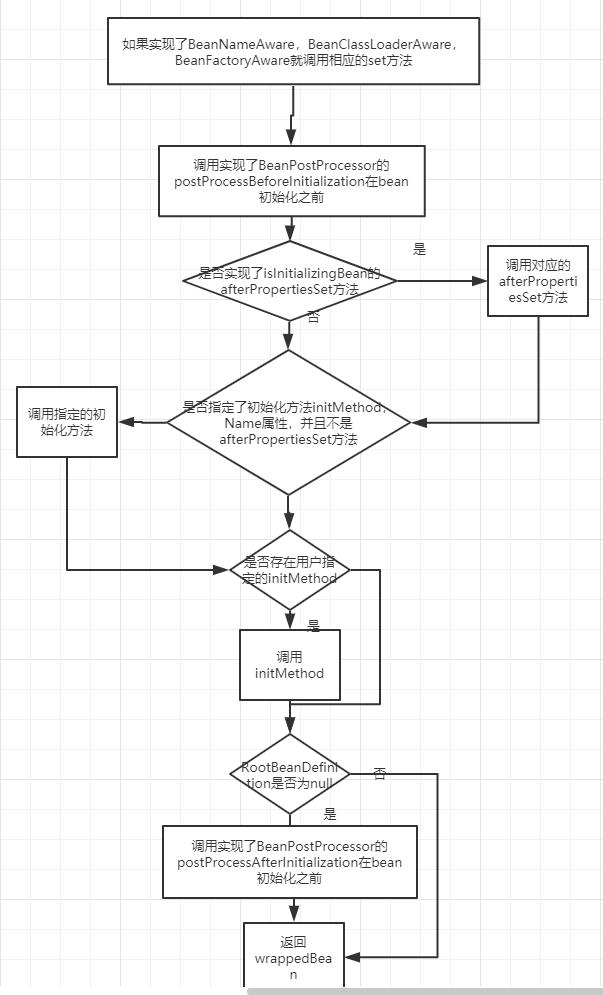
初始化Bean
BeanNameAware
,
BeanClassLoaderAware
,
BeanFactoryAware
则调用对应实现的方法 。
2、Bean不为null并且bean不是合成的,如果实现了
BeanPostProcessor
的
postProcessBeforeInitialization
则会调用实现的
postProcessBeforeInitialization
方法。
在
ApplicationContextAwareProcessor
类中实现了
postProcessBeforeInitialization
方法。
而这个类会在Spring刷新容器准备
beanFactory
的时候会加进去,这里就会被调用,而调用里面会检查Bean是不是
EnvironmentAware
,
EmbeddedValueResolverAware
,
ResourceLoaderAware
,
ApplicationEventPublisherAware
,
MessageSourceAware
,
ApplicationContextAware
的实现类。
这里就会调用对应的实现方法。
代码如下
protectedvoid prepareBeanFactory(ConfigurableListableBeanFactory beanFactory) {
.......
beanFactory.addBeanPostProcessor(newApplicationContextAwareProcessor(this));
.......
publicObject postProcessBeforeInitialization(Object bean, String beanName) throwsBeansException{
if(!(bean instanceofEnvironmentAware|| bean instanceofEmbeddedValueResolverAware||
bean instanceofResourceLoaderAware|| bean instanceofApplicationEventPublisherAware||
bean instanceofMessageSourceAware|| bean instanceofApplicationContextAware)){
return bean;
}
AccessControlContext acc = null;
if(System.getSecurityManager() != null) {
acc = this.applicationContext.getBeanFactory().getAccessControlContext();
}
if(acc != null) {
AccessController.doPrivileged((PrivilegedAction<Object>) () -> {
invokeAwareInterfaces(bean);
returnnull;
}, acc);
}
else{
invokeAwareInterfaces(bean);
}
return bean;
}
InitializingBean
的
afterPropertiesSet
方法,如果实现了就会调用
2、Bean不为null并且bean不是合成的,如果实现了
BeanPostProcessor
的
postProcessBeforeInitialization
则会调用实现的
postProcessAfterInitialization
方法。
三、destory方法跟销毁Bean
destroyMethodName
以及是否实现了
DestructionAwareBeanPostProcessor
接口的
requiresDestruction
方法,如果指定了会记录下来保存在
DisposableBeanAdapter
对象中并保存在bean的
disposableBeans
属性中。
代码在
AbstractBeanFactory
的
registerDisposableBeanIfNecessary
中
protectedvoid registerDisposableBeanIfNecessary(String beanName, Object bean, RootBeanDefinition mbd) {
......
registerDisposableBean(beanName,
newDisposableBeanAdapter(bean, beanName, mbd, getBeanPostProcessors(), acc));
......
}
publicDisposableBeanAdapter(Object bean, String beanName, RootBeanDefinition beanDefinition,
List<BeanPostProcessor> postProcessors, @NullableAccessControlContext acc) {
.......
String destroyMethodName = inferDestroyMethodIfNecessary(bean, beanDefinition);
if(destroyMethodName != null&& !(this.invokeDisposableBean && "destroy".equals(destroyMethodName)) &&
!beanDefinition.isExternallyManagedDestroyMethod(destroyMethodName)) {
......
this.destroyMethod = destroyMethod;
}
this.beanPostProcessors = filterPostProcessors(postProcessors, bean);
}
AbstractAutowireCapableBeanFactory
的
destroyBean
方法。
publicvoid destroyBean(Object existingBean) {
newDisposableBeanAdapter(existingBean, getBeanPostProcessors(), getAccessControlContext()).destroy();
}
DisposableBeanAdapter
对象,这个对象实现了Runnable接口,在实现的
run
方法中会调用实现的
DisposableBean
接口的
destroy
方法。
并且在创建
DisposableBeanAdapter
对象的时候会根据传入的bean是否实现了
DisposableBean
接口来设置
invokeDisposableBean
变量,这个变量表实有没有实现
DisposableBean
接口
publicDisposableBeanAdapter(Object bean, List<BeanPostProcessor> postProcessors, AccessControlContext acc) {
Assert.notNull(bean, "Disposable bean must not be null");
this.bean = bean;
this.beanName = bean.getClass().getName();
//根据传入的bean是否实现了`DisposableBean`接口来设置`invokeDisposableBean`变量
this.invokeDisposableBean = (this.bean instanceofDisposableBean);
this.nonPublicAccessAllowed = true;
this.acc = acc;
this.beanPostProcessors = filterPostProcessors(postProcessors, bean);
}
publicvoid destroy() {
......
//根据invokeDisposableBean决定是否调用destroy方法
if(this.invokeDisposableBean) {
if(logger.isTraceEnabled()) {
logger.trace("Invoking destroy() on bean with name '"+ this.beanName + "'");
}
try{
if(System.getSecurityManager() != null) {
AccessController.doPrivileged((PrivilegedExceptionAction<Object>) () -> {
((DisposableBean) this.bean).destroy();
returnnull;
}, this.acc);
}
else{
((DisposableBean) this.bean).destroy();
}
}
catch(Throwable ex) {
String msg = "Invocation of destroy method failed on bean with name '"+ this.beanName + "'";
if(logger.isDebugEnabled()) {
logger.warn(msg, ex);
}
else{
logger.warn(msg + ": "+ ex);
}
}
}
......
}
四、总结。
最后来一个大的流程

实例化前的准备阶段
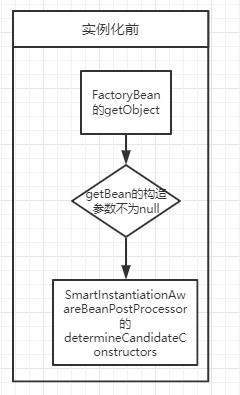
实例化前

实例化后
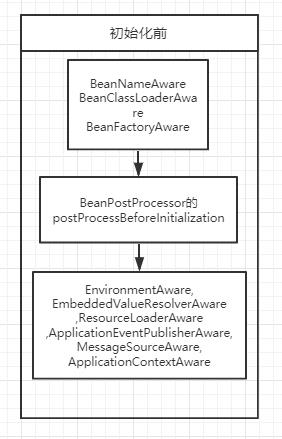
初始化前
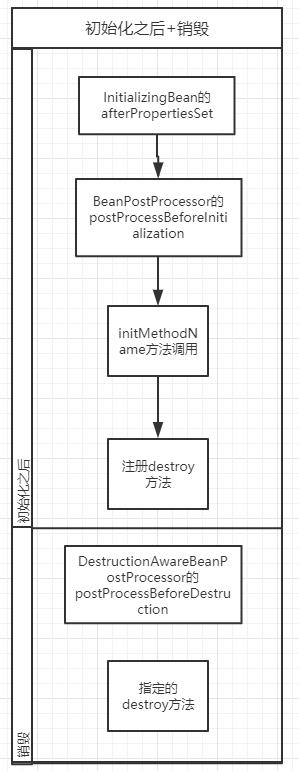
推荐↓↓↓
长
按
关
注
以上是关于Spring的Bean生命周期,11 张高清流程图及代码,深度解析的主要内容,如果未能解决你的问题,请参考以下文章